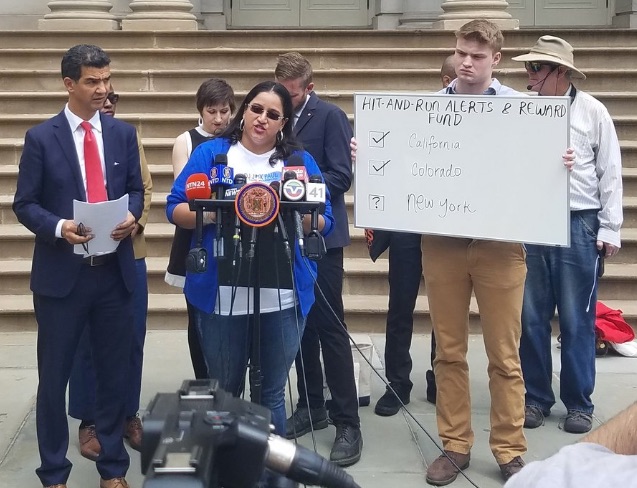NYPD and DOT offered testimony today in support of two City Council bills intended to help police catch hit-and-run drivers. However, Transportation Alternatives said the bills don’t cover enough types of crashes.
Intro 1463 would establish an “Amber Alert”-type system to facilitate public involvement in helping police track down hit-and-run drivers. The bill says alerts could be issued through email, texts, phone calls, and/or television and radio broadcasts.
Intro 1418 would allow for an award fund for information that leads to the “apprehension, prosecution, or conviction” of a motorist who injures or kills someone and leaves the scene.
City Council member and transportation committee chair Ydanis Rodriguez is the primary sponsor of both bills.
According to figures cited by Council Member Vanessa Gibson, there were 44,865 hit-and-run crashes in NYC in 2016, with only 510 drivers arrested. NYPD testified that 61 hit-and-run crashes last year resulted in death or critical injury, and 28 of those drivers were apprehended.
Around 40,000 hit-and-runs in 2016 involved property damage only -- leaving some 4,000 injury crashes that resulted in no arrest.
Though NYPD testified in favor of both bills, department officials expressed concern that too many alerts would desensitize the public. NYPD already disseminates information on hit-and-run vehicles through social media and other outlets, department brass said, and suggested that NYC's system, if adopted, should emulate those in other states, where alerts are sent out only when witnesses get a full license plate number or a partial plate number and a "good vehicle description." NYPD also wants alerts limited to serious injury crashes.
Council Member David Greenfield noted the thousands of injury-causing crashes that are never solved, and referred to hit-and-runs as an "epidemic." If a motorist breaks someone's leg and drives away, Greenfield said, the city should take that incident seriously.
In testimony, Transportation Alternatives Policy and Research Manager Julia Kite noted that the alert system bill defines hit-and-run as when a driver knows or has "cause to know that serious physical injury has been caused.”
The reward fund, meanwhile, would only apply in cases where a victim dies or sustains “serious physical injury" -- defined under state law as injuries that create substantial risk of death or long-term effects on bodily function.
“This limited definition is problematic because drivers who leave the scene of a crash rarely stop long enough to assess the severity of injuries to the victims, nor are most drivers equipped to make a diagnosis," said Kite. "Additionally, first responders often require a significant amount of time to determine injury severity.”
Instead, TransAlt proposed that the bills use NYC’s definition of personal injury, which would broaden crashes that trigger alerts and rewards to include injuries that are not life-threatening -- "reflecting that leaving the scene is egregious in and of itself,” Kite said.





